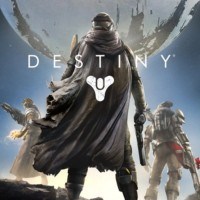The history of Destiny, part 1 – the world before the games
The first Destiny wasn’t really straightforward when it came to its plot, so we’re here to help you out. In this 2-part article we will explain the backstory of the world of Destiny.
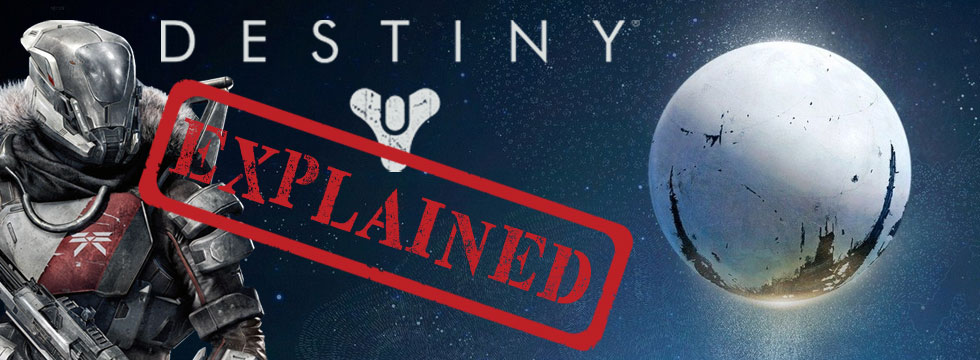
“I don’t even have time to explain why I don’t have time to explain” – this sentence, uttered by EXO Stranger in one of the few cutscenes in Destiny, is a perfect summary of the game’s plot. We’re thrown right into the middle of some mess and fight the malevolent Darkness on multiple worlds, being fed sparse bits of information from vaguely introduced characters. The greatest downside to the story, though, was not the virtual lack of plot or its shallowness; it was the way the narration was carried out. Instead of introducing the story to the players with something like audiologs, it was conveyed with a collection of Grimoire cards, available on bungie.net, after pairing it with your account.
To really get to know the universe of Destiny, we’ll have to become a historian of sorts, piecing together the past of an entire civilization using very limited sources, as not many cards give solid, direct information. Most of them simply contain random fragments of conversations, short eye-witness accounts of different events, official announcements, or data logs and journals that are usually completely out of context. However, there’s a great tale awaiting those who are willing to spend some time sorting the story out and interpreting it – a truly fascinating and epic tale of the prime and perishing of the human civilization, from colonization of the Cosmos to a total apocalypse. It’s a real space opera full of great battles, colorful characters and significant events that could all serve as a great starting point for many a movie or novel. Here’s the universe of Destiny by Bungie!
You don’t really have to be familiar with the plot of the first Destiny to be able to enjoy its sequel this September. Which doesn’t mean you shouldn’t get to know what’s what. It’s a pretty good space opera and let me now show you why.
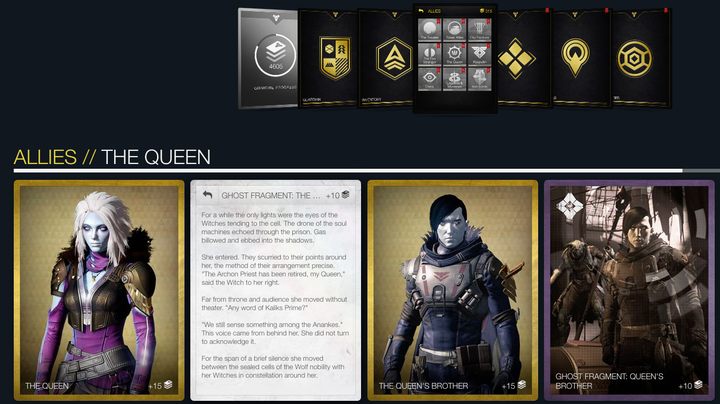
The pre-game history
From the very beginning, Destiny makes it clear that learning the story is not your main concern, and you generally don’t know much. You wake up somewhere on Earth, amidst a post-apocalyptic scenery. A small, flying cube starts talking to you, referring to itself as a “Ghost”. A minute later you grab a weirdly familiar gun and shoot some unfamiliar creatures. Vague mentions of the Golden Era and the evil Darkness don’t make things any clearer, and the Ghost’s prediction – “You’re going to see a lot of things that you won’t be able to understand” – is unfortunately true. The key to everything lies in understanding the events that took place hundreds of years before…
21st century
At some point during the 21st century, humans finally discovered they’re not alone in the Universe. A mysterious object appeared within the Solar System – a bizarre sphere that first stopped in the vicinity of Jupiter, then Mercury, and then Venus. Dubbed “The Traveler”, the sphere then moved towards Mars, and people back on Earth decided to investigate – the first manned mission to Mars became a reality. After the flight that lasted fourteen months, the Ares One mission reached the Red Planet, bringing astronauts from Russia, China and the USA to the Martian soil. The crew was surprised to discover that for the first time in millions of years, it was raining on Mars. The guns they took with them weren’t needed – the Traveler was far from hostile.
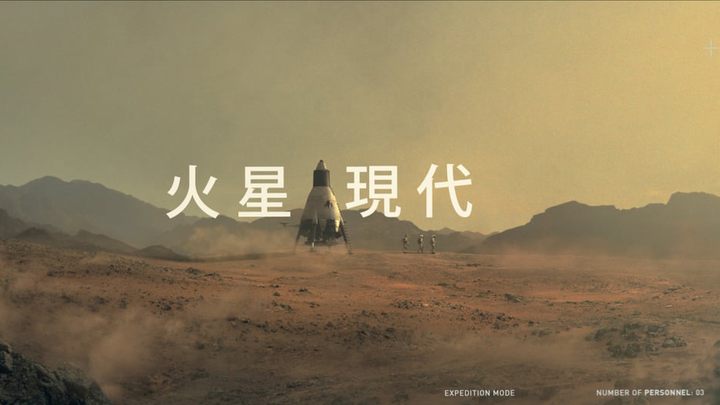
The Golden Age
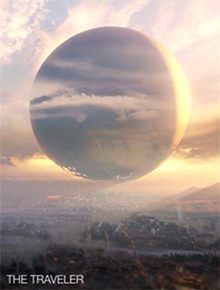
It still isn’t clear what the Traveler really was, where it was made or what part of the Universe it came from. It’s only known that it’s been traveling across galaxies for eons, and has helped more than one civilization before helping the dwellers of Earth. Some information about this can be found in the baffling poem, Dreams of Alpha Lupi, which explains the reasons for choosing Earth. The Traveler is claimed to have heard a “lucid melody” coming from the sun and detected a sort of “face” in it, which awakened hope and happiness within it for the first time in millennia.
The contact with The Traveler was a watershed for the Earth-kind. The space farer didn’t choose this civilization by accident; it didn’t share its enormous knowledge about practically every field of reality at random. This is when the Golden Era began – the primetime of the human race, lasting for about 300 years. The life expectancy grew three-fold, the Solar System was colonized – cities were erected on Venus, Mars and the moons of Jupiter, as all of them had been terraformed and made habitable by the Traveler.
The enormous Martian metropolis of Freehold, loaded with tall skyscrapers, was considered the greatest achievement in human history. On Venus, traces of an ancient civilization, the Vex, were found, and a research facility called Ishtar Academy was established to investigate the secrets of the mysterious aliens. It was discovered, for example, that the Vex were able to control time. On Earth, six immense military complexes were built and named the Warminds, since they were all controlled by AIs. A network of thousands of military satellites (the Warsats) scattered across the whole System enabled coordinated defense of Earth and its colonies.
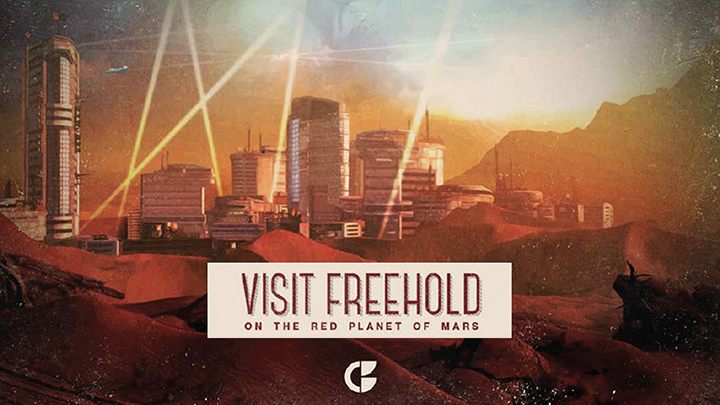
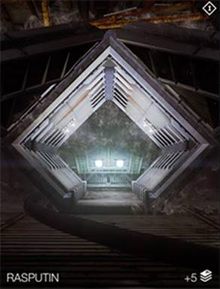
Rasputin, one of the six military AIs (Warminds) has a huge significance in Destiny’s lore. Another known Warmind was called Charlemange, and it was planned to be a part of the story – the name even appeared in promo materials before alpha tests, but the thread was ultimately dumped.
Around the middle of the Golden Era period, a corporation called Clovis Bray made a monumental breakthrough in science, discovering nanotechnology called SIVA, which was able to break down matter and reconstitute it, allowing virtually everything – including entire cities – to be instantly mended. The first SIVA replication chamber (Site-6) was built at a Russian spaceport to allow colonizing ships to be fitted with the technology. Roughly during the same period, the Glimmer (the game’s currency), was discovered as a by-product of programmable matter, as were the Engrams – the technology of encoding matter within crystals (decoding engrams in the game yields new equipment and weapons).
Another vastly important discovery was made during the dawn of the Golden Era – the research team at Ishtar Collective on Venus captured a living Vex! As a result of extensive research and numerous experiments performed on this mysterious, cybernetic creature, the scientists were able to manufacture artificial warriors, called the EXO, as well as develop a device that enabled them to see into the future. For reasons that remain unknown, a small secret military group, Future War Cult, was created after these discoveries were made. Shortly after, the first eerie event happened – a small expedition from the First Light colony went missing during a mission on the Moon, where they were supposed to investigate a complex of underground tunnels. Eventually it was discovered that the expedition had stumbled upon bones – huge bones, the size of a jet’s fuselage – of a dangerous type of worms and something even more horrific. Nobody survived.
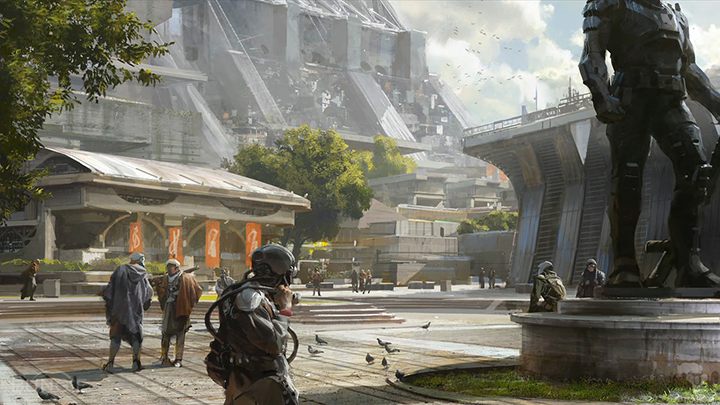
The Collapse
All good things come to an end. Humanity had to pay the highest price for its astonishing period of prosperity. The Darkness – The Traveler’s eternal enemy – appeared in the Solar System. It aimed to destroy not only The Traveler, but also the entire human civilization. Not many humans walked away to tell the tale, so no one really knows what the Darkness exactly is. Is it a higher form of an independent being, or something more tangible? Most interpretations and theories didn’t appear until after the Collapse.
Something hit us. Knocked us down and tried to stamp us out. No one knows exactly what, but we do know this: very few of us survived!
-- The Speaker
Just how mysterious were the events that brought the Collapse upon the human civilization, and what impenetrable riddle the Darkness posed is shown by the Speaker in the trailer of the first Destiny. Everything is so mysterious that we’re not exactly sure what happened to humanity: was it decimated during some inexplicable events, or did it perish during an alien invasion? Some consider the Darkness to be the opposite of the Traveler – a force that ensures balance in the Universe. Another theory states that an alien civilization wants revenge on the Traveler for abandoning it centuries before.
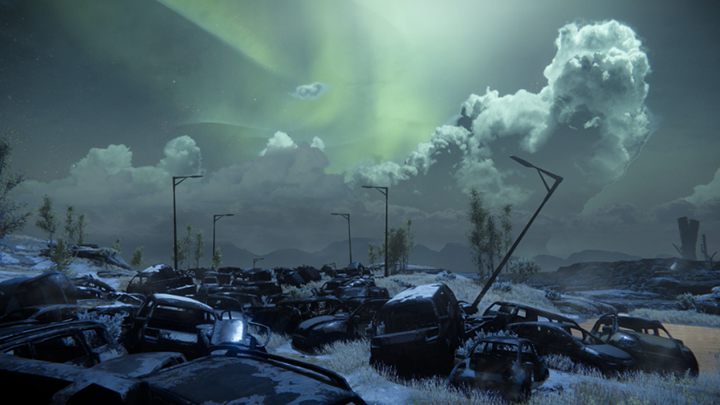
Rasputin’s War
Whatever that was, it was far beyond human capabilities to defy it. Utilizing the technology left behind by the Future War Cult, the Warmind AI known as Rasputin came up with a way to launch a grand-scale attack from space. In face of the threat, the Traveler ceased its work on Io (one of Jupiter’s moons – we visit this place in Destiny 2) and proceeded towards Earth. Rasputin, having assumed control of all of Earth’s defenses, attacked with all the power it could muster – but to no avail.
Realizing the attack was ineffective and foreseeing that no form of defense or attack would be useful against the might of the Darkness, the AI decided to initiate the Midnight Exigent protocol, deactivating all forces from combat and entering a period of hibernation. This was supposed to allow it to wait for a better opportunity to strike. Rasputin also had one more directive prepared, in case the very survival of human race was at risk, called the Abhorrent Imperative. It assumed attacking The Traveler in case it wanted to leave the Solar System in order to immobilize it, hence forcing it to fight for survival of itself, and, consequently, of humans. What really went down after that is not clear either, and although some Grimoire cards seem to confirm Rasputin’s attack, it seems that the Traveler, for the first time in history, decided to stay in an endangered system to help a civilization fight the Darkness, even though it had always run away from it in the past.

The origin of the Awoken
The hibernation of Rasputin and the very likely destruction of the remaining Warminds left Earth utterly exposed and defenseless. The colonists that had previously escaped from other planets now had to flee again, forced to leave their home world and seek shelter within the empty and cold vacuum of the Solar System. Those who managed to leave Earth, reached the asteroid belt between Mars and Jupiter, where they met with significant resistance of the Darkness. The armada of Golden-Era space ships turned into dust, forming a cemetery, and then merging with the asteroids to eventually create the Reef.
This tragic event had a silver lining, though. Some of the refugees miraculously survived; something remarkable happened to them. As they were simultaneously exposed to radiation of both the Light (the force of the Traveler) and the Darkness, they became altered. A new race was created – a more resilient, humanoid race of the Awoken. The new humans moved to Mars, in time colonized the Reef, and some of them returned to Earth. The Awoken established their own society, with the queen, Mara Sov, as the supreme leader.
The Traveler’s last battle
The Darkness attacked the defenseless Earth, hoping to annihilate every last human, but the Traveler joined the fight. In the last, monumental counterattack it pushed the Darkness back, sacrificing itself. A huge chunk of the Traveler fell somewhere on Europe (the site of the impact is one of the locations in Destiny 2), and the giant itself hovered statically over one of Earth’s regions, providing a habitable piece of land beneath it. Nobody really knew whether the unfathomable savior of humanity became comatose or otherwise turned itself off.
In its final act of creation, the Traveler gave humans the Ghosts – small machines which were the source of its power, the Light. The main task of the Ghosts was to look for fallen warriors and resurrect them so that they were able to continue the fight against the Darkness as the Guardians – the new protectors of humanity. The Traveler was no longer able to defend Earth, but thanks to its power the Guardians gained superhuman abilities and – as long as their Ghost existed – immortality. The rest of the survivors entered the next era – the Dark Age.
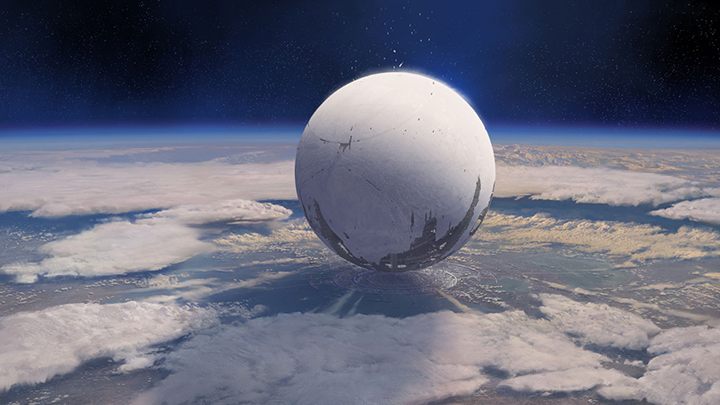
Dark Age
The enemies outside and within
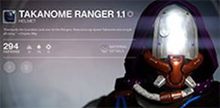
Most of the universe’s greatest heroes are commemorated in the game with equipment and weapons named after them. The Hunters, for example, can proudly wear a Ranger’s armor; one of the cloaks was named after Ayane.
The collapse brought humans on the verge of annihilation. The survivors formed small groups to help each other out. Since Rasputin went into hibernation, the EXO soldiers had no supervision. Eventually, they developed their own consciousness and learned to function among people. Some of the Awoken came back to Earth, and their race, as well as the EXO, gave the planet many Guardians, who fought the Darkness. However, before the Ghosts gave humans an army of the warriors of the Light, the civilians were protected by the Rangers, led by the legendary Ayane Takanome. Armed with sniper rifles and cloaks that provided invisibility, they guarded roads and settlements.
The beginning of the Guardian army, back then still referred to as the Risen, was a shameful chapter of the fight against the Darkness. Some of the original Guardians, drunk on the unexpected power, became ruthless Warlords, often fighting each other for turf. The civilians under their “care” were forced to pay for protection and ruthlessly punished in case of insubordination. To make matters worse, the defenseless Solar System caught the attention of alien civilizations. At the beginning of the Dark Age, Earth was attacked by the Fallen – plundering space pirates, who – as it later turned out – had a bigger goal: to take over the Traveler.
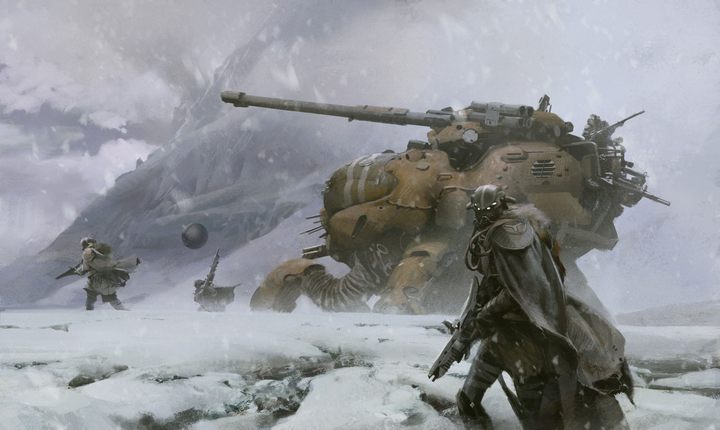
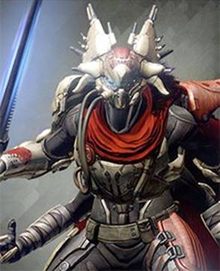
The Fallen were not your regular pirates – their presence in the Solar System was not a coincidence. Once they were a proud Eliksni race, adhering to a strict clan hierarchy. At some point in their history, they too were aided by the Traveler (which they called the Great Machine), taking advantage of its vast knowledge. However, when the Darkness came, the entity abandoned them, leaving them to their own fate. After these events, they succumbed to civil wars, only to leave their home system in pursuit of the Traveler and the Darkness, with one goal only: to capture the Great Machine and use it again, to rebuild their empire.
The time of the Iron Lords
The brutal reign of the warlords soon met with severe opposition of the nobler warriors. The legendary figures of those times, Radegast and Perun, decided to put the tyrants’ rule to an end, and, along with Jolder and Saladian, they created the faction of Iron Lords, recruiting an ever-increasing army of trustworthy Risen. One of the Warlords, Felwinter, decided to switch sides and join the Lords, offering them his stronghold inside the Felwinter Peak to prove his dedication. During the following conflict, the Lords managed to crush the Warlords after many bloody battles. They built a shrine on the summit of their mountain – the Iron Temple, and, leading an army of several hundred men and women, swore to protect humanity instead of wasting their power on internal conflicts, and thus established a path of righteousness that all future Guardians were to follow.
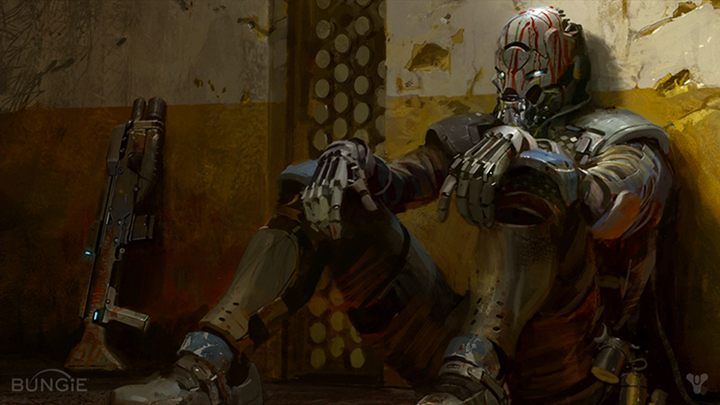
The dawn of the Dark Age – the invasion of the Cabal
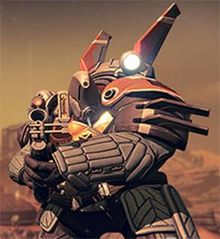
The Cabal took a liking to Mars. Due to their size, way of fighting and the characteristic armor, they were dubbed “War Rhinos”, or “Space Turtles”.
Another race of warriors appeared in the Solar System – the Cabal. Before their invasion on Mars they established a foothold on one of its moons, Phobos. The Cabal are the only race that does not believe in any higher being – their only purpose is to fight and conquer. Contrary to the Fallen, they had probably never met the Traveler and are not fleeing the Darkness. They were drawn to Mars because of the resources, but discovering the Vex on the Red Planet also generated a fascination with their technology, which they also tried to study on Mercury. We also know that later on, they became interested in the power of the Light bore by the Guardians and the ability to resurrect deceased allies. The first Risen who were sent to Mars in response to the Cabal invasion did not come back.
On Earth, protected by the Iron Lords, humans were finally able to start rebuilding their civilization. A small settlement in the shadow of the Traveler slowly started to grow into a bustling city. After the apocalypse, the humanity slowly began to get back from its knees.
The City Age
From settlement to metropolis

The factions of the Last City are important for the gameplay. By joining either of them, the players increase their level of loyalty with each completed mission, which, in turn, provides numerous bonuses – weapons, armors and spaceships.
The city was created thanks to the cooperation between humans, the EXO and the Awoken, but it was born in great peril. With the exception of the Iron Lords, the people didn’t have much to do outside the city, so many of them focused on internal politics. They joined different factions that soon started to fight for control over the city, with the guardians being the main military power of them all. A series of quarrels soon evolved into a conflict known as Faction Wars. Brother turned against brother, and the fighting only ceased after all were faced with common threat: the Fallen. The war ended with a peace treaty. Three factions: Dead Orbit, Concordat and New Monarchy created a city council called The Consensus, led by the Speaker. An elite guard was appointed to defend the city – the Vanguard, led by Osiris – and the Risen guards ultimately became the Guardians. The first Titans (a class of guardians bound to the City much stronger than anyone else) sealed the metropolis off with defensive walls. Eight turrets were built along the perimeter, but ultimately only one remained. Named the Tower, it became the seat of the Speaker and the leader of the Vanguard.
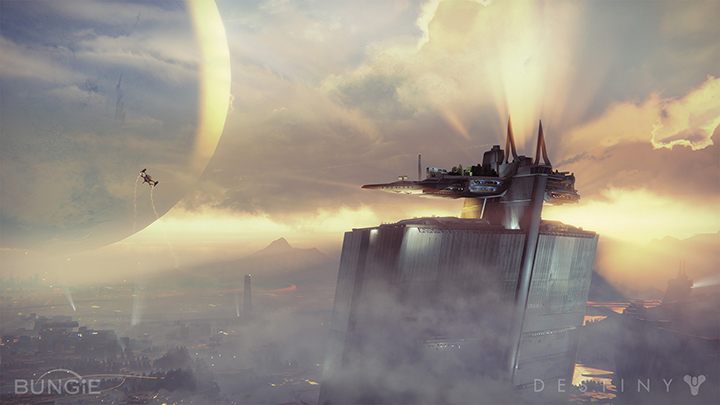
Battles of the Last City
Both the PvP games fought between friendly Guardians and the co-op Strike missions are not in the game just because they are vastly popular game modes in FPS games. In Destiny, they have a certain story background, and they’re justified in terms of the plot.
Urged by the sight of the defenseless Traveler, the Fallen finally assembled an armada big enough to be able to assault the Last City. Four Titan armies, led by the Iron Lords, managed to fend off six consecutive attacks of the Fallen in the Battle of Six Fronts. Not one hostile unit managed to break through into the City – the Titans, on the other hand, controlled a 5-mile-wide stretch of land beyond the city walls.
In turn, the Battle of Twilight Gap, coming some time later, had much griever consequences. Thousands of Guardians were killed fighting the Fallen in a derelict military complex outside the City. During both battles, side by side with Lord Saladin, fought his young disciples – Zavala and Shaxx. The latter, terrified with the enormous casualties, later organized a system of Crucible trainings – simulations of battles between the Guardians, in order to avoid so many deaths in the future. The leader of the Vanguard, Osiris, would often order Strikes – short missions of small (3 people) Guardian teams intended to eliminate key alien leaders.
The perishing of the Iron Lords
Knowing the story of the Iron Lords is of key significance when it comes to understanding the plot of the newest expansion to Destiny – Rise of Iron.
Somewhere between the Battle of Six Fronts and the Battle of Twilight Gap, an expedition of the Iron Lords was exploring the area of the Spaceport. By chance, they stumbled upon the ruins of Clovis Bray corporation buildings, which led them to discovering information about Site-6 and SIVA – the previously mentioned nanotechnology that was able to create virtually anything. Obsessed with the idea of the return to the greatness of the Golden Era, the Lords decided to use SIVA to rebuild their might. The entire army of Iron Lords was sent to Old Russia with a mission of finding SIVA and Site-6. During that mission, they awoke Rasputin (the AI that controlled all of Earth’s defenses) by accident.
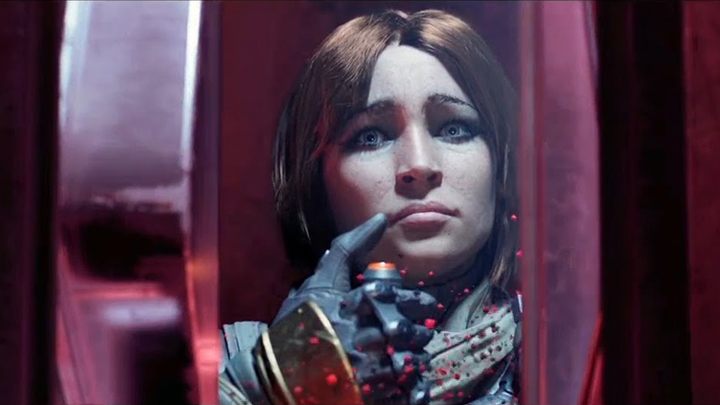
Rasputin recognized the Lords inside the top-secret facilities as hostiles and attacked. The Lords were decimated with orbital bombardment, and only nine people survived. The small team reached the SIVA replication chamber only to see SIVA, which had been reprogrammed by Rasputin, complete the bloodbath and infect the remaining Lords. One of the Titans, Lady Jolder, upon realizing that the end is inevitable, decided to stop the nanotechnology. She sealed herself with the other infected within a chamber and initiated a powerful explosion. Only two people ultimately survived this mission – Lord Saladin and Lady Efrideet. The distraught Saladin closed the Iron Temple on Felwinter Peak and set off to the City, where he organized a special Crucible tournament – Iron Banner. Efrideet disappeared without a trace.

The recurring tournament called Iron Banner for Destiny players was always about PvP and took place once a month. It lasted one full week – from Tuesday to Tuesday. Unique, Iron-Lords-themed prizes (armors, weapons, Ghosts’ shells, ships and Sparrow jumpships) distinguished it from other PvP games. It was also a fast way to earn more Light.
The Battle of the Moon
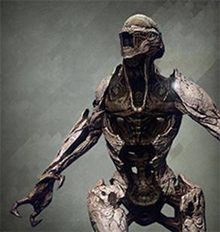
The Hive brings to mind creatures from the worst human nightmares. It’s an ancient race of undead royalty. They can spend centuries concealed somewhere among the stars, increasing their power, or roam the Cosmos in ships that are also their sarcophagi.
During The Great Disaster campaign, the Thunderbolt assault rifle was constructed by one of the Titans. The shattered gun is the objective of one of the longer side quests in Destiny.
The invasion of the Fallen wasn’t the greatest threat humanity had to face. The Hive proved to be much more dangerous. This ancient race of rotten creatures, blindly serving the Darkness, yearned for utter destruction of the Traveler, which was the opposite of all their beliefs and values. Their only crusade, the sole purpose of their existence was the destruction of all Light, so that the Darkness would again reign the Universe. It’s not entirely clear whether humanity stumbled upon the Hive during the Collapse. It is assumed they had been hidden on the Moon for ages, dormant, waiting for the opportunity to invade Earth. Sometime in the City Era, the Hive were discovered by the Guardians on the Moon – the first clash with them is known as the Battle of Burning Lake. Having no data whatsoever about the enemy’s numbers or weapons, the Vanguard opted for a swift counteroffensive, in spite of great opposition of Lord Shaxx.
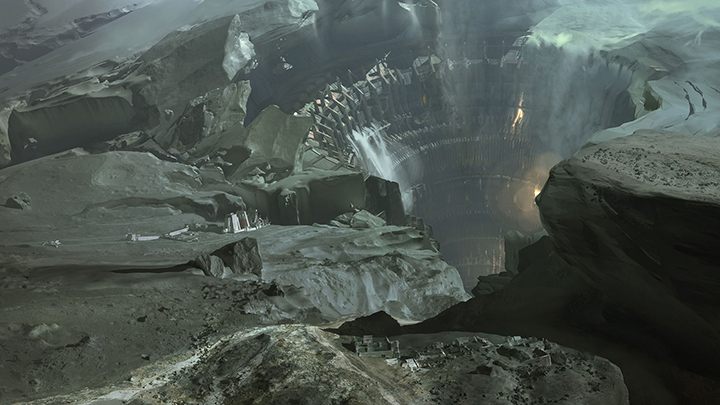
Thousands of Guardians clashed with the Hive in a battle that later became known as The Great Disaster. Legions of the Hive, led by god-prince Crota, butchered countless units of the Guardians, bereaving them of the Light. After the grave defeat, the Vanguard ordered a full retreat from the Moon and pronounced it a forbidden area. Eriana-3, one of the few Guardians that survived the slaughter, dedicated all her time and energy to investigate any potential weaknesses of Crota. Finally, during a secret mission, she infiltrated the Hellmouth fortress on the Moon with five other Guardians, with whom she actually managed to kill the physical vessel of the Hive prince, but not his soul. During the escape from the Hellmouth tunnels, almost the entire party was killed, apart from one person – Eris Morn.
Other significant events preceding the story of the game
Some changes reached the City itself. Osiris was expelled by the Speaker for his obsession with the Vex, and the Concordat, after a failed coup, was replaced in the City Council with Future War Cult. The Vanguard had three representatives chosen – Zavala, Ikora Rey and Cayde-6 – who were the best in each of their respective classes. A clan of the Fallen – House of Exile (consisting of outcasts from the Fallen’s society) – appeared on the Moon, attacking and pillaging the Hive’s fortress.
We follow in Kabr’s footsteps in the first raid of Destiny – Vault of Glass – which is the most captivating and the best-designed PvE mission in the game to date.
In the meantime, a team of six Guardians landed on Venus, hoping to get to the mysterious chamber of the Vex – the Vault of Glass – and learn all the secrets of that race. Being unable to defeat one of the guards, the enormous Templar, the Guardians took shelter deeper within the facility. The Vault of Glass turned out to be the place where the Vex controlled reality by manipulating time itself, having the ability to erase traces of existence of any being. Such fate met three members of the team; another one was lost, leaving no trace. The leader of the mission, a Titan named Kabr, spent a long time inside the maze of the facility’s hallways, and even built himself an armor from parts of fallen enemies, which, however, slowly started to dominate his mind. He wanted to avoid dying in vain, so he forged the power of the Light from his Ghost into an extraordinary shield – the Aegis, which would help future Guardian expeditions in the Vault of Glass to defeat its guards and save them from being erased. Again, only one person survived the fatal expedition – Phanin – who later created a machine gun called Super Good Advice.
It’s around this point in Destiny’s timeline that the Ghost awakes our protagonist’s body among the car wreckages somewhere in the Old Russia. We become a Guardian. And Destiny begins.
This is the end of the first part of our recap of the world of Destiny. In a week or so we will publish the second article that will cover the story of the original game, together with all its expansions.
